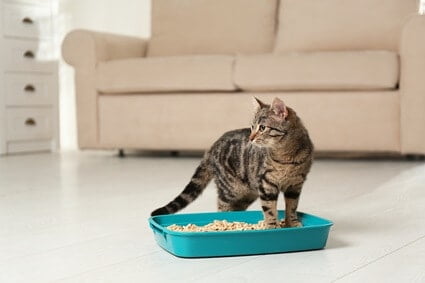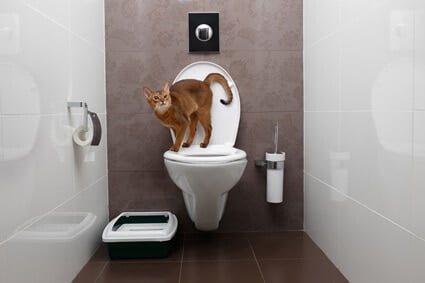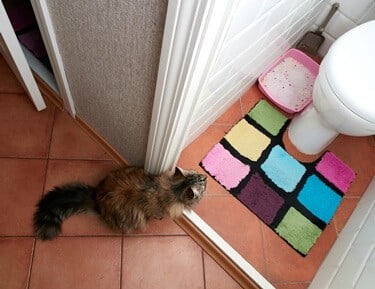If you live in a small apartment, be it a studio or one-bedroom apartment, finding space isn’t easy. Litter boxes smell bad, and you can’t put the box near the cat’s food or water. However, you can place the litter tray in a place that doesn’t take up much space or expose you to the smell of cat poop and urine.
In a small apartment, put your cat’s litter box in a non-carpeted, isolated room. Good litter tray locations include the bathroom, linen closet, utility room, near a window, away from the kitchen, or in a corner. Change the litter daily and/or get an enclosed box to limit any bad odor.
You need to consider how your cat will reach its litter tray. If your cat cannot find or easily access its litter box, you’ll need to relocate it. Having a secluded, easy to clean spot won’t work if your cat dislikes the location. In very small apartments, specialty-built litter box furniture can be a good solution.
Litter Box Smell in a Studio Apartment
If your apartment has a small bathroom with no space for a litter box, you’ll need to get creative. You won’t have the benefit of an extra room or added closets, unlike a house.
The best approach is to get specialized furniture or modify your existing furniture to house your cat’s litter box. For example, you can install a cat flap into a bedside cabinet.
Consider fitting curtains around a tiered side table, as this can create a multifunctional piece of furniture to discreetly hold your cat’s litter box.
When placing a litter box in specialized areas, keep the limited space in mind. Avoid certain shortcuts. For example, having it next to your bed or near your food preparation area is a bad idea.
Instead, place the litter box somewhere in your main living area. Ensure that it’s away from the main traffic routes in your apartment and far from the door entrance.
Placing litter box furniture near a window can minimize odor.
What To Do With A Litter Box In A Small Apartment
If you have a small apartment with 1-2 bedrooms, you have more options.
Consider any spare rooms or closets. For example, a linen closet that’s not often used will be ideal as it’s out of the way, doesn’t get much use or foot traffic, and is easy to clean.
Where is a Good Place to Put a Litter Box in an Apartment?
The best rooms for your cat’s litter box are the bathroom or kitchen. Ensure that the litter box is away from food preparation areas. Alternatively, consider rooms that see low traffic, like spare bedrooms.
Don’t leave your cat’s litter box out in the open, no matter where it sits. Place the litter box in a:
- Corner of the room
- Modified piece of furniture
- Enclosed space, such as under the kitchen sink
The key is to ensure that your cat can access their litter box when it needs to go. In that case, any contained space with enough room for it and the litter box will be sufficient.
Worst Place for A Litter Box
Keep your cat’s litter box far away from surfaces used for food preparation.
According to Zoonoses and Public Health, litter boxes are crucial to public health, as well as the health of your home, because of the bacteria in cat feces, known as T. gondii.
T. gondii is harmful and can lead to a condition known as toxoplasmosis. According to The New England Journal of Medicine, toxoplasmosis can occur due to exposure to cat feces.
It may cause blindness, seizures, and brain infections like encephalitis. Those who are pregnant or have compromised immune systems are particularly at risk.
The worst place for a cat’s litter box in a small apartment would be:
- Directly next to food preparation areas
- In high traffic areas where it is likely to be kicked or spilled
- Near your bed, where you may breathe in the odors throughout the night

How Much Distance Between Litter Box and Food?
Felines are creatures of habit that like to stay clean and tidy. For this reason, avoid keeping your cat’s litter box in the same room as their food.
Putting their litter box in a cupboard or enclosed space may help, of course. However, if your cat’s litter box is in the kitchen, you should put its food elsewhere.
Likewise, don’t keep an open or unenclosed litter box near your food or food preparation area. In a studio apartment, you may not have many options.
In that event, place the box far away from the kitchen. Alternatively, get a litter box that is, itself, enclosed in a way that contains the dirt, germs, and smell.
Choosing a Good Litter Box for Apartment
Choosing the best litter box for your cat and your apartment can be tricky. However, getting it right can make living with a cat in a small apartment more comfortable and healthy for you both.
Enclosed Or Open
Consider if you want an open or enclosed litter box for your cat. If you have a timid or nervous feline, an enclosed litter box may be more comfortable for it.
If an enclosed box isn’t suitable, look for one with high sidewalls. Some litter boxes have tall sides and an in-built entrance port to prevent spillage as your cat tries to bury its poop.
Type of Material
Consider how the material of the litter box will affect the cleaning process. Does the litter box have handles for carrying and dumping the used material? Is it slick plastic that’s easy to wash down?
Coatings
Consider whether the litter box has an antimicrobial coating. This can control odor and limit bacteria.

Best Cat Litter for Apartments
There is no single right cat litter. Instead, there are several factors to consider when making your choice.
All homes can benefit from cat litter with no tracking (keeping your floors clean and hygienic). However, the other factors that surround choosing cat litter are more subjective.
You need to consider the following:
- Whether your cat has any allergies
- The size of the pellets
- If the material clumps easily
- How often it needs to be changed for hygiene purposes
- If you want perfumed or non-perfumed cat litter
Odor control shouldn’t be an issue if you get the right non-perfumed cat litter. That is, as long as you’re emptying the litter box and cleaning it regularly.
How to Clean a Litter Box When You Live in an Apartment
While most cat litters can be changed once a week, others may need to be changed daily.
Get rid of the soiled litter and feces in a trash bag. Then, seal this bag and put it in an outdoor dumpster.
After that, clean the box. If you have the right cat litter, you shouldn’t find any soiled material stuck to the inside of the litter box. If you do, remove the soiled material and sanitize the inside of the litter box.
Once that’s done, you can refill the box with new litter. Don’t fill it to the brim, or else the cat might scatter litter everywhere when it’s digging to cover its poop.
Getting Rid of the Litter Box Smell
If your litter box smells, change it more often. Otherwise, you may need to take extra steps when cleaning it. Dispose of the soiled litter, removing it from your home if you want to get rid of the smell entirely.
Once you’ve done this, mix a solution of detergent and hot water to clean the litter box shell. Of course, before you put new litter in, dry the box.
Once the litter box is dry, refill it with fresh litter. Afterward, you should have no issue at all with the litter box smell in your home. You can minimize odor by spot cleaning and removing soiled clumps of litter and droppings during the week. If you do this, you’ll find that your cat’s litter box is easier to live with.

